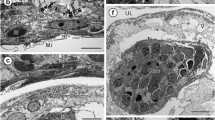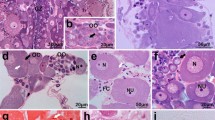Abstract
The final stages of embryonic development in the oviduct, transport of the embryo to the uterus, and the initial stages of implantation have been examined in captive-bred Carollia perspicillata at the light and electron microscopic levels. Development progressed to the expanded, zona pellucida-free, blastocyst stage in the oviduct. The abundance of microvilli on the exterior of the trophoblast varied with the degree of blastocyst expansion and cell shape, and may function in part as a membrane reservoir. Cells of the blastocyst also typically contained many lipid droplets and prominent areas of cytoplasm occupied by finely granular material (probably glycogen) instead of organelles. In most females, closure of the uterine lumen occurred prior to, or around the time of, transport of the blastocyst to the usual implantation site and appeared to play a role in preventing transport of the blastocyst too far distally in the uterus. This was associated with increased endometrial edema, particularly in the fundic region of the simplex uterus, and the extravasation of many erythrocytes into the endometrial stroma. Both of these changes began while the blastocyst was still being held in the oviduct and became pronounced during implantation. Engulfment of these erythrocytes by processes of the endometrial stromal cells and their phagocytosis by macrophages was also observed. Implantation was usually initiated within narrow tubular segments, lined by endometrium, that were located between the end of each oviduct and the main cavity of the uterus, or from immediately adjacent areas of the main cavity. During the early stages of implantation, the blastocyst was clasped by the endometrium at the implantation site, and this was associated with extensive interdigitation of the microvilli of the trophoblast and adjacent uterine epithelial cells. Initial adhesion of the trophoblast, which was still cellular rather than syncytial, occurred over the apical intercellular junctions of the uterine epithelial cells.
Similar content being viewed by others
Author information
Authors and Affiliations
Additional information
Accepted: 18 October 1999
Rights and permissions
About this article
Cite this article
Oliveira, S., Rasweiler IV, J. & Badwaik, N. Advanced oviductal development, transport to the preferred implantation site, and attachment of the blastocyst in captive-bred, short-tailed fruit bats, Carollia perspicillata . Anat Embryol 201, 357–381 (2000). https://doi.org/10.1007/s004290050325
Issue Date:
DOI: https://doi.org/10.1007/s004290050325




